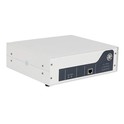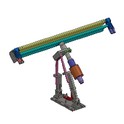In the realm of materials science and engineering, surface treatment of materials stands as a crucial process that significantly influences the performance, durability, and functionality of various products. One innovative technology that has emerged as a game - changer in this field is the universal ultrasonic generator. As a leading supplier of universal ultrasonic generators, I am excited to delve into how these devices can revolutionize the surface treatment of materials.
Understanding Universal Ultrasonic Generators
Universal ultrasonic generators are advanced pieces of equipment designed to produce high - frequency electrical signals that are then converted into mechanical vibrations by ultrasonic transducers. These generators are "universal" because they can be adjusted to work with different types of ultrasonic transducers and can operate at various frequencies and power levels. For instance, we offer 2000W Ultrasonic Generator, 4000W Ultrasonic Generator, and 3000W Ultrasonic Generator, each catering to different industrial requirements.
The Mechanism of Ultrasonic - Assisted Surface Treatment
The core principle behind ultrasonic - assisted surface treatment lies in the phenomenon of cavitation. When an ultrasonic wave propagates through a liquid medium, it creates alternating high - and low - pressure cycles. During the low - pressure phase, tiny bubbles, or cavities, are formed in the liquid. In the subsequent high - pressure phase, these bubbles collapse violently, generating intense shock waves and micro - jets. These shock waves and micro - jets can exert high - energy forces on the surface of the material being treated.
Surface Cleaning
One of the most common applications of universal ultrasonic generators in surface treatment is cleaning. Traditional cleaning methods may not be able to reach all the nooks and crannies of a complex - shaped material or remove stubborn contaminants. Ultrasonic cleaning, on the other hand, can penetrate deep into the smallest pores and crevices of the material surface.
The shock waves and micro - jets produced by cavitation dislodge dirt, grease, and other contaminants from the material surface. For example, in the automotive industry, engine parts can be effectively cleaned using ultrasonic generators. The high - frequency vibrations can remove carbon deposits, oil residues, and metal shavings from the internal surfaces of engine components, ensuring optimal performance and extending the lifespan of the parts.
Surface Polishing
Universal ultrasonic generators can also be used for surface polishing. In conventional polishing, abrasive materials are used to mechanically remove the surface irregularities of a material. However, this process may cause scratches or damage to the material surface. Ultrasonic polishing offers a more gentle and precise alternative.
The ultrasonic vibrations cause the abrasive particles in the polishing slurry to move in a highly agitated manner. This agitation allows the abrasive particles to uniformly remove the surface asperities of the material, resulting in a smooth and mirror - like finish. Moreover, ultrasonic polishing can be applied to a wide range of materials, including metals, ceramics, and glass.
Surface Coating and Deposition
Another significant application of universal ultrasonic generators is in surface coating and deposition processes. In many industries, such as electronics and aerospace, it is essential to apply thin and uniform coatings on the surface of materials to enhance their corrosion resistance, electrical conductivity, or other properties.


Ultrasonic waves can improve the adhesion and uniformity of the coating material. During the coating process, the ultrasonic vibrations can break up agglomerates in the coating solution, ensuring a more homogeneous distribution of the coating particles. Additionally, the shock waves generated by cavitation can help the coating material to penetrate into the micro - pores of the material surface, improving the bonding strength between the coating and the substrate.
Modifying Surface Properties
Universal ultrasonic generators can also be used to modify the surface properties of materials at the micro - and nano - scale. The high - energy shock waves and micro - jets produced by cavitation can induce plastic deformation on the material surface. This plastic deformation can change the grain structure of the material, leading to improved hardness, wear resistance, and fatigue resistance.
For example, in the manufacturing of medical implants, the surface properties of titanium alloys can be enhanced using ultrasonic treatment. The modified surface can promote better cell adhesion and proliferation, which is crucial for the integration of the implant with the surrounding tissue.
Advantages of Using Universal Ultrasonic Generators in Surface Treatment
There are several advantages of using universal ultrasonic generators in surface treatment. Firstly, they offer a high degree of precision and control. The frequency, power, and duration of the ultrasonic waves can be easily adjusted according to the specific requirements of the material and the treatment process.
Secondly, ultrasonic treatment is a non - contact process, which means that there is no direct physical contact between the treatment equipment and the material surface. This reduces the risk of damage to the material and allows for the treatment of delicate or fragile materials.
Thirdly, ultrasonic surface treatment is an environmentally friendly process. It typically uses water - based cleaning solutions or polishing slurries, which are less harmful to the environment compared to some traditional chemical - based treatment methods.
Case Studies
Let's take a look at some real - world case studies to illustrate the effectiveness of universal ultrasonic generators in surface treatment.
In a metalworking factory, a company was struggling to clean the complex - shaped metal parts used in their products. The traditional cleaning methods were time - consuming and did not effectively remove the contaminants from the internal surfaces of the parts. After implementing an ultrasonic cleaning system with a 3000W Ultrasonic Generator, the cleaning time was significantly reduced, and the parts were cleaner than ever before. This led to an improvement in the overall quality of the products and a reduction in production costs.
In the semiconductor industry, a manufacturer was facing challenges in achieving a uniform coating on the surface of silicon wafers. The uneven coating was causing problems in the electrical performance of the semiconductor devices. By using an ultrasonic - assisted coating system with a 2000W Ultrasonic Generator, the manufacturer was able to achieve a highly uniform coating, resulting in improved device performance and yield.
Conclusion
In conclusion, universal ultrasonic generators have a profound impact on the surface treatment of materials. They offer a wide range of applications, from cleaning and polishing to coating and surface property modification. The advantages of precision, non - contact treatment, and environmental friendliness make them an ideal choice for many industries.
As a leading supplier of universal ultrasonic generators, we are committed to providing high - quality products and excellent technical support to our customers. Whether you are looking for a solution to clean your industrial parts, polish a delicate material, or improve the surface coating of your products, our universal ultrasonic generators can meet your needs.
If you are interested in learning more about how our universal ultrasonic generators can benefit your surface treatment processes or would like to discuss your specific requirements, please feel free to reach out to us. We are eager to engage in procurement discussions and help you find the most suitable ultrasonic solution for your business.
References
- Mason, T. J., & Lorimer, J. P. (2002). Applied sonochemistry: uses of power ultrasound in chemistry and processing. Wiley.
- Suslick, K. S. (1990). Sonochemistry. Science, 247(4944), 1439 - 1445.
- Zhong, Z., & Guo, X. (2016). Ultrasonic - assisted surface engineering: A review. Journal of Materials Processing Technology, 237, 133 - 148.




